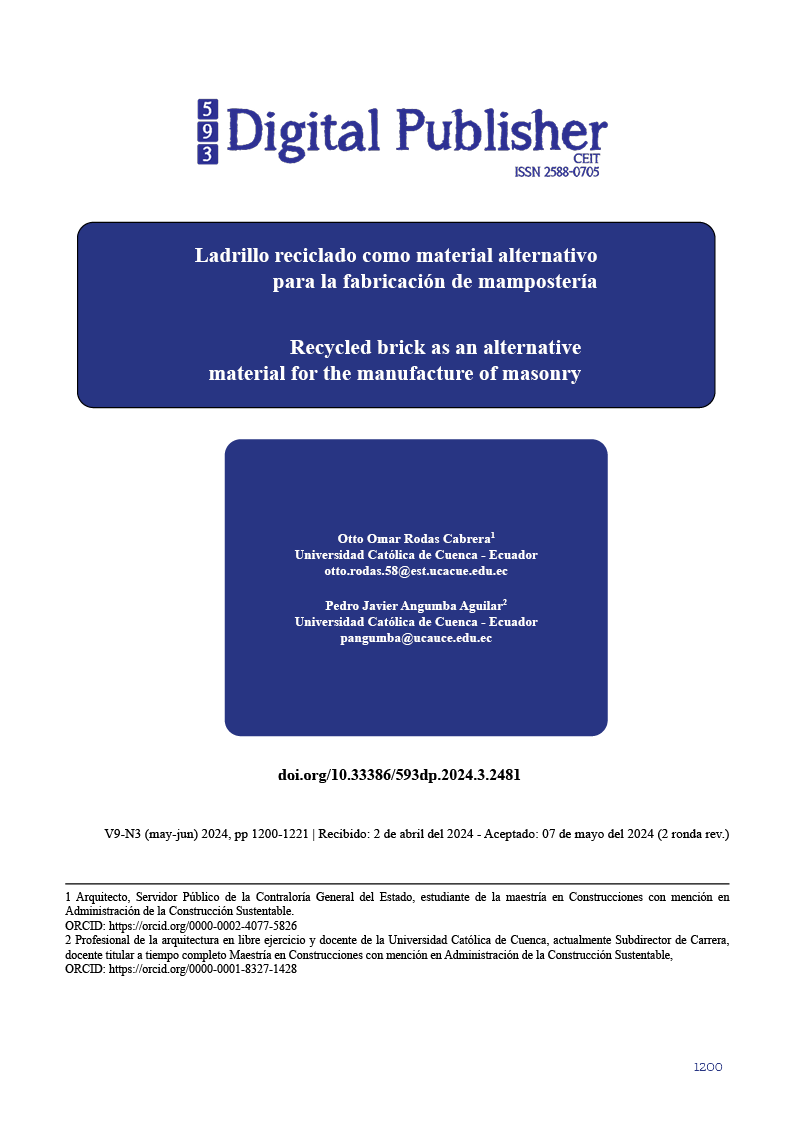Recycled brick as an alternative material for the manufacture of masonry
Main Article Content
Abstract
The construction industry is responsible for 75% of the consumption of the earth's natural resources and its waste represents 50% of the volume disposed of in landfills, generating negative impacts for the economy, society and the environment. In the city of Cuenca, a monthly average of 25,000 m3 of debris is recorded. Brick and concrete represent 75% of construction waste. The objective of this research is to determine the volume of discarded brick and its technical characteristics, to constitute it as an alternative material in the manufacture of a masonry element, contributing to the reduction of the consumption of natural resources and environmental pollution. This research is of a mixed type, (quantitative and qualitative) experimental that collects data provided by the expert builders of the College of Architects of Azuay through a digital survey and the review of bibliographic information. As a result, the 1,250 buildings built by these professionals generate 656.25 m3 of discarded brick per year, being considered an alternative material for the manufacture of the new masonry element. Based on the reviewed bibliography, 2 types of blocks were made, replacing the pumice material with crushed brick. The blocks that replaced 30% of the coarse aggregate (Type B) increased their weight by 15% and maintained their compressive strength and met the requirement demanded by the Ecuadorian Technical Standard and the demands of this research; while those that replaced 100% of the powder volume obtained unsatisfactory results, their weight was similar, but their compressive strength was reduced to 47%. The manufacture of 60 Type B blocks will save 0.18 m3 of natural material and their use in a 150 m2 house will avoid the natural exploitation of 15 m3 of natural material.
Downloads
Article Details

This work is licensed under a Creative Commons Attribution-NonCommercial-ShareAlike 4.0 International License.
1. Derechos de autor
Las obras que se publican en 593 Digital Publisher CEIT están sujetas a los siguientes términos:
1.1. 593 Digital Publisher CEIT, conserva los derechos patrimoniales (copyright) de las obras publicadas, favorece y permite la reutilización de las mismas bajo la licencia Licencia Creative Commons 4.0 de Reconocimiento-NoComercial-CompartirIgual 4.0, por lo cual se pueden copiar, usar, difundir, transmitir y exponer públicamente, siempre que:
1.1.a. Se cite la autoría y fuente original de su publicación (revista, editorial, URL).
1.1.b. No se usen para fines comerciales u onerosos.
1.1.c. Se mencione la existencia y especificaciones de esta licencia de uso.
References
¿Qué materiales de construcción son más fáciles de reciclar? - Infobae. (n.d.). Retrieved July 16, 2022, from https://www.infobae.com/economia/real-estate/2019/10/21/que-materiales-de-construccion-son-mas-faciles-de-reciclar/
Adesina, A., & Awoyera, P. (2019). Overview of trends in the application of waste materials in self-compacting concrete production. In SN Applied Sciences (Vol. 1, Issue 9). Springer Nature. https://doi.org/10.1007/s42452-019-1012-4
Augusto Euphrosino, C., Jacintho, A. E. P. G. de A., Lorena Pimentel, L., Camarini, G., & Fontanini, P. S. P. (2022). Tijolos de solo-cimento usados para Habitação de Interesse social (HIS) em mutirão: estudo de caso em olaria comunitária. Matéria (Rio de Janeiro), 27(1). https://doi.org/10.1590/1517-7076-rmat-2021-47087
Cachim, P. B. (2009). Mechanical properties of brick aggregate concrete. Construction and Building Materials, 23(3), 1292–1297. https://doi.org/10.1016/j.conbuildmat.2008.07.023
Domingo, N., & Batty, T. (2021). Construction waste modelling for residential construction projects in New Zealand to enhance design outcomes. Waste Management, 120, 484–493. https://doi.org/10.1016/j.wasman.2020.10.010
Escombrera – EMAC. (n.d.). Retrieved July 17, 2022, from https://emac.gob.ec/servicios/escombrera/
Ghaffar, S. H., Burman, M., & Braimah, N. (2020). Pathways to circular construction: An integrated management of construction and demolition waste for resource recovery. Journal of Cleaner Production, 244. https://doi.org/10.1016/j.jclepro.2019.118710
Kazemi, M., Madandoust, R., & de Brito, J. (2019). Compressive strength assessment of recycled aggregate concrete using Schmidt rebound hammer and core testing. Construction and Building Materials, 224, 630–638. https://doi.org/10.1016/j.conbuildmat.2019.07.110
Khatib, J. M. (2005). Properties of concrete incorporating fine recycled aggregate. Cement and Concrete Research, 35(4), 763–769. https://doi.org/10.1016/j.cemconres.2004.06.017
Kisku, N., Joshi, H., Ansari, M., Panda, S. K., Nayak, S., & Dutta, S. C. (2017). A critical review and assessment for usage of recycled aggregate as sustainable construction material. In Construction and Building Materials (Vol. 131, pp. 721–740). Elsevier Ltd. https://doi.org/10.1016/j.conbuildmat.2016.11.029
Krauklis, A. E., Karl, C. W., Gagani, A. I., & Jørgensen, J. K. (2021). Composite material recycling technology—state-of-the-art and sustainable development for the 2020s. In Journal of Composites Science (Vol. 5, Issue 1). MDPI AG. https://doi.org/10.3390/jcs5010028
Minunno, R., O’Grady, T., Morrison, G. M., Gruner, R. L., & Colling, M. (2018). Strategies for applying the circular economy to prefabricated buildings. Buildings, 8(9). https://doi.org/10.3390/buildings8090125
Muñoz-Pérez, S. P., Mimbela-Orderique, F., & Rodriguez-Lafitte, E. D. (2021). Uso de ladrillos triturados en concreto: una revisión literaria. Revista Politécnica, 17(34), 82–100. https://doi.org/10.33571/rpolitec.v17n34a6
Narcis, N., Ray, I., & Hosein, G. (2019). Construction and demolition waste management actions and potential benefits: A perspective from Trinidad and Tobago. Buildings, 9(6). https://doi.org/10.3390/BUILDINGS9060150
Sathiparan, N., Subramaniam, D. N., Malsara, K. G. N., & Akmal, M. S. M. (2022). Thermal comfort analysis of fired-clay brick, cement-sand block and cement stabilized earth block masonry house models. Innovative Infrastructure Solutions, 7(2), 147. https://doi.org/10.1007/s41062-022-00744-9
Ullauri, M. C. A., Romero Bastidas, M., Bustamante, J. R., & Castillo Carchipulla, E. (n.d.). El ladrillo artesanal de Cuenca (Ecuador): una caracterización inicial en el marco patrimonial. https://doi.org/10.14568/cp26915
Wong, C. L., Mo, K. H., Yap, S. P., Alengaram, U. J., & Ling, T. C. (2018). Potential use of brick waste as alternate concrete-making materials: A review. In Journal of Cleaner Production (Vol. 195, pp. 226–239). Elsevier Ltd. https://doi.org/10.1016/j.jclepro.2018.05.193
Zanelli, C., Marrocchino, E., Guarini, G., Toffano, A., Vaccaro, C., & Dondi, M. (2021). Recycling Construction and Demolition Residues in Clay Bricks. Applied Sciences, 11(19), 8918. https://doi.org/10.3390/app11198918
Zhang, Z., Wong, Y. C., Arulrajah, A., & Horpibulsuk, S. (2018). A review of studies on bricks using alternative materials and approaches. In Construction and Building Materials (Vol. 188, pp. 1101–1118). Elsevier Ltd. https://doi.org/10.1016/j.conbuildmat.2018.08.152

